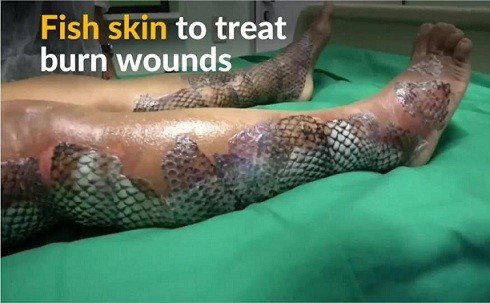Grafting Of Fish Skin Onto Humans Is Getting More Advanced
The field of medical science is not left out of the insane advancements happening in the world of Science and emerging Technology. Believe me when I tell you that science is advancing astronomically.
Using animal skins to graft onto human skin is really not much of a new thing, at least not to the uninitiated. We may have known or seen the process of grafting pig skin onto humans. But the process of grafting fish skin onto human is newer than the rest of them (it was popularized in 2016); and as such, it is experiencing amazing researches in that field.
One of the major researchers in this field is Professor Odorico de Morais and his team at university of Ceara in Brazil.

They have revolutionized the field of Plastic, Reconstruction, and Aesthetic Surgery with the treatment of second and third degree burns using fish skin.
Before now, the most viable treatment of acute burn is "human" skin grafting. The process is usually preceded by an extensive surgical debridement, which will see to the removal of the burnt part. The human graft (from the donor site: either from the patient or another human) was usually used to cover up the debrided site.
As advances were made in skin grafting, pig skin came on the scene as an alternative (this is due to the similarities in both human and pig skins). But a better alternative was being sought for grafting; thanks to this discovery: "fish skin" it is.
Viability of fish skin
Fish skin has been proven (through systematic reviews of randomize trials) to contain the rare Type1 and Type2 collagen. This collagen is needful for healing and scarring. The most fascinating aspect is; this collagen is more abundant in fish (Tilapia) than even in humans.

A particular specie of Tilapia fish has been proven to be more disease-resistant; this is the one best suited for the process. The experimentation yielded a better result.
The process begins with the harvesting of the skin, which is followed by the removal of scales, muscle, and even odours. To make it more viable, the skin is stretched and laminated. In this form, it can be stored over time.
Healing features of fish skin
- It has natural pain inhibiting effect (there won't be need for much analgesics).
- Potency on storage: The chemical structure would remain relatively unchanged on storage. That is why you can refrigerate a laminated fish skin for more than 2 years.
- It is almost not rejected by the human body. I guess nature has taken care of the issue of "matching and cross-matching".
In conclusion
This process, when fully advanced, will potentially sideline the need for human-human skin donation. Also, the readily availability of fish will be a huge plus for the actualization of this, and scientists can leverage on that.
When next you see Tilapia fish, show some respect; they're potential life savers :)
Thanks for reading
References for further reading: Ref1, Ref2, Ref3


fascinating read and such an amazing new option. I love it when science thinks outside the box. Obviously a lot of science follows the dots, but occasionally looking at the bizarre and obscure can reveal options that would not be intuitive. Who'd've thought of lower transplant reactivity in fish than some mammal? Very cool.
Thanks a lot. The world of science is evolving rapidly
Wow, interesting to know.
Thanks a lot
And I just finished roasting one tilapia fish ooo... But I go still chop am
Lol. Onto point-and-kill levels naa. Na dat one make sense pass oo